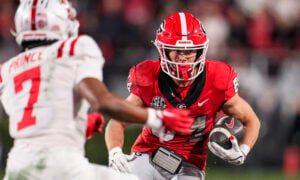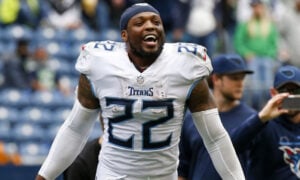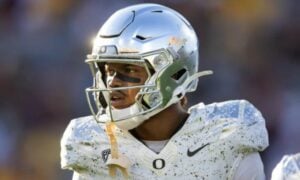Of Fantasy & Parrots – What’s the Connection?
Sometimes you just have to mix it up!
The brainy parrot, at least some varieties, are said to have the intelligence of a four year old child in addition to the ability to reason. Some even have vocabularies of hundreds of words, any number of which they seemingly enjoy vocalizing ad-nauseam. So famous are our avian friends for this action that there exists a word derived from it: parroting. For those not wishing to follow the link, the second definition from dictionary.com states that parroting is: a person who, without thought or understanding, merely repeats the words or imitate the actions of another.
Certainly you can already see where I’m headed.
From April and May (rookie draft season) and again in July and August (fantasy draft season), the parroting is literarily (if you’ll allow me to create a word here) deafening. From large network personalities, coaches, small-time scouts, fantasy experts and fantasy players alike, the parroting of ‘popular belief’ is as common as is the common cold. What’s more is that every year, the fantasy masses get caught up in this activity as well and like sheep off a cliff, follow each other to their collective deaths – or the fantasy draft equivalent thereof.
To be sure, not all parroting is incorrect or misguided. Quite the contrary, much of it could be insightful and dead-on, it is up to you, the fantasy player, to consider the source carefully and determine for yourself if what you’re hearing is true insight born from experience or simple information migration from a parrot. And make no mistake, the results of your decisions could prove to be catastrophic, extremely beneficial or anything in between. The exercise that I strongly urge you to undertake is to strongly consider group-think statements and ascertain for yourself the likelihood that they are correct or incorrect. We, the fantasy community, love to stereotype players and attack what appears to be an anomaly or outlier, sometimes without even a hint of research or objective reasoning toward determining future probability. There’s a strong need in our circle to be the voice of reason or the truth and it’s sexy to be the loudest. At least until proven incorrect.
Timed just right or from the right individual and these thoughts stick, are parroted and become group-think. Within this group-think lies tremendous opportunity for those willing to stand outside the circle, if only for a few moments while more research is done. The impact of group-think can be seen in every fantasy draft, rookie analysis or projections for the year to come. These thoughts as they take hold become reality for those unwilling or unable to research on their own – and opportunities for those that are willing and able.
It’s draft season and in this article I seek to lay bare some of the group-think statements that are affecting this year’s fantasy players and their respective values in hopes of going a bit deeper. Through this exercise I hope to determine if the path of least resistance is, indeed, following the group-think rationale, or perhaps an opportunity to capitalize on a value proposition unrealized by most others. Either way, this should yield value for your upcoming drafts.
This year I have a full book of squawking that I’ve assembled but I went to the best community of fantasy experts on the planet for many of the statements to research (most of which were already on my list already) – that community being our own DLF forum! So let’s get down to business and attempt to see if we can separate fact from folly.
Squawk #1: Allen Robinson can’t match his TD production from 2015
The 6’3″ youngster (22) did jump from two touchdowns in 2014 over 10 games to 14 touchdowns in 2015. Looking more closely at the numbers, Robinson scored on 14 of his 80 receptions, a 17.5% clip. That’s pretty good, but not quite as good as Doug Baldwin’s 14 scores on 78 receptions. Close enough.
56 receivers have notched 14 touchdowns or more in a single season. Of those, only six have done it twice or more. Those names are Terrell Owens, Randy Moss, Jerry Rice, Marvin Harrison, Mark Clayton and Art Powell. Pretty exclusive company. For Allen Robinson to match this mark again in 2016, he’ll need to join this elite club.
Much of the discussion around Robinson’s as well as Blake Bortles’ production is based upon the fact that the Jaguars were down big in games, allowing for fantasy production during what is affectionately called garbage time. It certainly is true that the Jags were not good in 2015, finishing 5-11 on the season. Those games that Robinson caught a touchdown but still lost by more than 7 points? 2. This is far from a statistical study suggesting that Robinson’s touchdowns came at meaningful times during games, but the Jags did have their moments and were in games.
Robinson’s 80 receptions on 151 targets are not over-the-top or unable to be reproduced. I fully expect Robinson to be within 10% of his reception total again in 2016, with an upside of 88 total receptions though I do not see him being able to match his touchdown-to-catch percentage of 17.5% as a more run-balanced offense and healthy receiver options should make for more well-balanced offensive distribution overall. An increase in defensive attention and distribution should mute Robinson’s numbers somewhat.
Verdict: True. I believe Robinson maintains his status as a top receiver in fantasy, pulling down 82 receptions for 1,325 yards and 12 touchdowns, but shy of his 2015 performance. But not enough to significantly downgrade his value. While I do expect Jacksonville’s offense to be more balanced and for this to come out of Robinson’s production (it almost has to), that doesn’t suggest he’s not a top tier performer. He most certainly is.
Squawk #2: Jeremy Langford was lackluster in 2015 and is destined to be eventually replaced
I listened to a ridiculous debate on satellite radio this past week between two relatively well-known fantasy individuals. Ridiculous being defined as it crossed the line between being a healthy, good-for-radio, discussion about a player’s value and turned into a, let’s keep it family oriented here, who’s boat is bigger discussion. On one hand we have fantasy expert #1 who has purportedly watched every Jeremy Langford carry from 2015. Expert #2 is metric driven and crawls inside of numbers and metrics to a degree that makes me question “where’s the fun left in the game?”. Safe to say both were painfully arguing the question: Will Jeremy Langford be relevant in 2016 and beyond?
I watched a lot of Langford’s tape as he emerged from Michigan St. and firmly believed that he was a fantastic upside sleeper in last year’s rookie draft, often had in the third round. Langford finished 2015 with 537 yards on 148 carries and six touchdowns, in addition to 22 receptions, 279 yards and a single touchdown. Pedestrian numbers to be sure. But one season does not a career make. Nor can it be completed discounted.
Langford is a good-sized back at 6′ ad 208 lbs. In fact, I believe he plays significantly bigger than his listed weight. He’s not a slashing runner, runs a bit more upright than I like but shows enough shoulder, leg drive and the ability to hit a crease to churn out yardage before and after contact. It’s arguable when looking into the metrics whether this should be expected or not. For my taste, I don’t really care. I concern myself far more for what I see and what year two tells me about Jeremy Langford the football player. There’s an important point here: Player metrics don’t dictate future performance. They may not even suggest future performance – where you fall on that statement likely determines your thoughts on Langford’s future.
But where to from here?
First thing to remember – Jeremy Langford was a rookie in 2015! This is an important fact. Chicago also allowed Matt Forte‘ to walk in free agency and drafted hard-nosed runner Jordan Howard in the 2016 rookie draft. Looking further into Langford’s production, he didn’t garner significant work until week seven vs. Minnesota. In fact, in weeks one through six, Langford only amassed 15 carries, 34 yards (2.27 ypc.) and one touchdown. Nothing to write home about in these numbers and he looked … very much like a rookie. In his remaining 10 games, he produced 133 carries for 503 yards (3.78 ypc.) and five touchdowns. Over his last six games, 70 carries, 287 yards ( 4.1 ypc.) and one touchdown. Note the improvement in his yards per carry.
Two words (names): Marshawn Lynch.
You might ask why I would bring up Beast Mode in a discussion about Jeremy Langford. No, I don’t believe they have similar run styles but I want to highlight something very important about running back development: Scheme Understanding and Development.
In 2010 when Lynch was traded from Buffalo to Seattle, I remember one of my league mates, from my longest running dynasty league, said “Happy Birthday”. Lynch then went on to post his lowest ypc. average in his career, rushing for 573 yards on 165 carries (3.5 ypc.) and six touchdowns. Do those numbers look similar? The point here is that a rookie runner is much like a veteran runner traded into a new system, with little chemistry or scheme understanding. It takes time for chemistry to be generated, trust to be created with the runner’s offensive line and where the seams and creases will likely be appearing. To wit, the following year Lynch returned to his normal productivity, rushing for 1,204 yards on 285 carries along with 12 touchdowns.
This is in no way an argument for Langford’s production to reach 1,200 yards or 12 touchdowns but, instead, an example of what can occur with young or inexperienced running backs, especially rookies. I would never consider Langford a ‘gifted’ runner but having watched much of his tape, I do most certainly believe that he’s a capable runner with upside. I’d like to see him play closer to 220 lbs. and receive at least 250 carries in 2016. If he can establish himself during training camp, 2016 should be his year to shine or fade based on his production.
Verdict: False. I don’t believe Langford’s destiny is to be replaced in 2016. While I’m not going to call Langford a RB1 or even an RB2, I do believe he’s a very good RB3 with upside if he can show between-the-tackle-ability and continue his development. Applying metrics to a rookie runner behind a fair-at-best offensive line is a poor strategy if you plan to identify upside players that are not currently household names. You must, instead, go with what’s in front of you and accurately place players in rankings based upon their production vs. their upside. I believe Langford provides upside value in new drafts, but I also strongly suggest adding Jordan Howard as well. Langford’s biggest threat isn’t his running style or last year’s lackluster numbers but, instead, John Fox who has an eye for young runners and isn’t afraid to turn to them. Draft accordingly.
Squawk #3: Alex Collins is too slow, has an unimpressive college tape and is being over-drafted
I’m going to get right to the point on this one. The parrots have been out in force on Collins from before the NFL draft and it’s been deafening.
Alex Collins:
- …is a sluggish athlete
- …is not a favorite of the analytics crowd
- …doesn’t bring anything special to the table
- …college tape left a lot to be desired
- …has the inability to beat defenders
- … is a replacement level runner
To be honest, all of these probably have some merit in the context of certain aspects but I know what I’ve seen on tape and despite what the metrics people wish to portray, I’m not seeing it. I’m not saying the metrics aren’t correct, just that at the existence of them doesn’t dictate failure. Collins won’t win many competitions to the ‘edge’, he won’t break tackles like Adrian Peterson and he doesn’t have the short area quickness of Jamaal Charles. Furthermore, I’ve seen statement after statement proclaiming that his college tape elicits no excitement or intrigue. But ever-so recently, Collins’ value is beginning to percolate and the jungle has gotten quiet.
At 5’11” and 217 lbs., Collins reminds me a LOT of Marshawn Lynch as he emerged from Cal. He’s not the bruising the runner that Lynch was but they are both angular, jerky runners that aren’t fluid with the ball in their hands, but are productive. In three years at Arkansas, Collins managed 3,703 yards on 665 carries, good for 5.6 ypc. and 36 touchdowns. He’s never been tasked with consistently being a receiver out of the backfield but has shown some ability. His two primary drawbacks are his momentum into contact and fumbling, having lost 9 of 17. Either of these, if not improved could spell the end of Collins’ pro career very quickly.
On tape, however, I see plenty to get excited about, much like I did with Lynch. Others have made comparisons to Chris Ivory and Mark Ingram, both of which I do see some similarities to. But regardless of who you wish to stack him up against, I see a runner that shows instinct, determination, angular speed and choppy, quicker-than-given-credit-for, feet into space. I see enough vision, shoulder and lower leg drive to believe discipline and technique can be developed at the next level.
On the Seahawks, behind a shaky Thomas Rawls, anything is possible. To wit, the Hawks also tabbed C.J. Prosise well ahead of Collins in the rookie draft. Prosise, himself, is an intriguing talent but raw and inexperienced as a runner. He has natural receiving abilities as a converted wide receiver and good size (6’0″/220 lbs.) with a lot of upside. As a runner, however, I still prefer Collins.
Verdict: False – But with a footnote. I can’t call Collins’ tape unimpressive in the least. He’s a competitive runner that churned out greater than 1,000 yards each of his three seasons at Arkansas. The footnote here is that he is NOT being over-drafted. Collins did slip into the bottom of the second round of some 12 team drafts shortly after the NFL draft, but has been consistently sliding in value until only recently. Last value check shows Collins coming off the board toward the end of the third round in rookie drafts and, often times, in the fourth. In recent dynasty drafts, Collins is a late teens (round) selection. If he slips, give him a shot.
Squawk #4: Amari Cooper is a top wide receiver
One of the tough parts about being a fantasy writer is staying objective unless, of course, the piece is persuasive in nature. In some cases, it’s impossible as we, too, have our favorite players and teams and can be protective of them. Personally, I’ve found it pretty easy to be separate my thoughts into two separate camps: 1) Enthusiasm and desire for my favorite players to do well and 2) What I REALLY think about a player’s potential. Some may think that these lines are blurred in my own statements, but they’re not. I may not always portray these camps well, but I assure you that they’re present and fully understood. Amari Cooper is one of those players that exists squarely in the gray area for me. This area being one that I have no particular fondness for, nor distaste. The research done related to his forecasts and potential was done from an extremely neutral bias.
I must admit that Amari Cooper rose quickly on my rookie and draft boards due to how he paints, wields his brush so to speak or practices his art. The end result was extremely visible on tape while still at Alabama and he commanded attention and respect. It was an earned occurrence that he shared (Todd Gurley) the marquee as the top rookie player in 2015 on my board. Watching him perform in the NFL was merely a revisit of what I saw when viewing tape. He’s a savvy, wily, route-runner that just carries natural instinct with him off the LoS (Line of Scrimmage). He possesses plus size and speed and and is only 22 years of age. He’s so naturally gifted at his craft that the path of least resistance is continued success.
Best of all, as a rookie he posted over 1,000 yards (1,070) and six touchdowns, putting him in relatively rare company. Until just recently, it was a rare occurrence for a rookie receiver to eclipse 1,000 yards. Since 2005, only six have but three of them came in 2014 (Odell Beckham, Mike Evans and Kelvin Benjamin). 2016 is a difficult year to project as Derek Carr and the young Oakland offense both continue to develop.
So the question stands as to whether or not Cooper’s single year of NFL production is enough to catapult him to status as one of the top receivers in fantasy.
Verdict: True. In a new start up draft, I don’t see Cooper falling outside the top 15 selections and fully believe that he’s capable of holding down a value within the top ten. At only 22 years of age, he is an extremely well developed route-runner, ultra-mature and just too talented not to produce for the next decade barring injury. The Oakland offense and supporting cast could hold back his production but some players naturally transcend their systems, team outlook and quarterback situation, Amari Cooper is such a player. Few players carry less risk than does Cooper when considering mental, physical and character make-up. He’s a cornerstone receiver that I still prefer as a WR2 in 2016, but fully expect to take the next step.
Summary
I hope you’ve enjoyed this piece and that you can use some of these examples in your upcoming drafts. More than these examples, however, is the message that each of us MUST be willing to do our own work and not blindly parrot the monologue of others. There are certainly many experts that are deserving of your attention and respect, those that work hard in developing their opinions and projections of players. These opinions don’t discount their expertise but as a fantasy coach, pay careful attention when group-think appears to be forming as it can be used to your advantage.
As group-think forms and player value begins to rise quickly, let this be the event in which you being your own research, find others the believe differently or in any other way uncover the truth about the situation. If the player is carrying too much value, there may be a trade opportunity to unload picks to a hungry parrot-impacted coach. Too little value, pounce on the player above his current ADP. Either way, use group-think to your advantage and challenge yourself not to simply get sucked in to being a parrot.
Follow me on Twitter: @DLF_Jeff
- Lineup Advice: Wrap-up, Thank You and Goodbye (TTFN) - January 1, 2024
- Lineup Advice: Week 17 – Championship Edition - December 26, 2023
- Lineup Advice: Week 16 – The “What is” Edition - December 19, 2023


































































